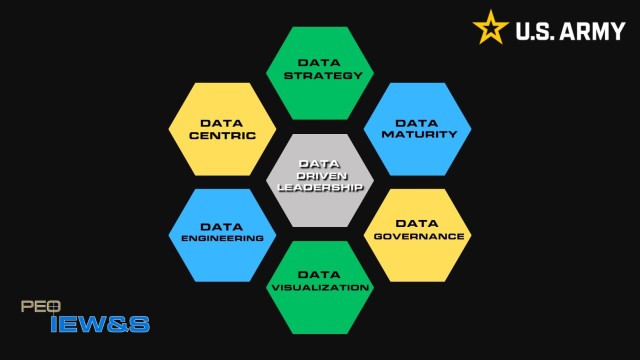By Robert W. Mitchell
Army leaders at Program Executive Office Intelligence, Electronic Warfare and Sensors (PEO IEW&S) learned about data-centric organizations at the Army Data Driven Leadership Certificate Program, a collaborative executive training by the U.S. Army and Carnegie Mellon University’s Heinz College. In line with the Army’s plan to restructure its force into a data-centric organization, senior leaders from Program Executive Office Intelligence, Electronic Warfare and Sensors (PEO IEW&S) participated in the Army Data Driven Leadership Certificate Program, a collaborative executive training program between Carnegie Mellon University’s Heinz College and the U.S. Army aimed at preparing government leaders to navigate the complexities of building and managing data-centric organizations.
PEO IEW&S leaders participated in recent cohorts of the program held in Pittsburgh, Penn. The week-long course covered a wide range of topics from data engineering, data visualization, data strategy and governance, to data maturity, data analytics, applied data science, building a data culture, and demystifying AI (artificial intelligence).
“It provided the right amount of information at the appropriate depths so that [Army] leaders can understand how a data-centric organization can help them achieve their strategic goals,” said Col. Michael Williams, PEO IEW&S Integration Directorate Chief.
From an operational perspective, being data-focused serves to sharpen Army decision-making and planning at all levels, according to Williams.
“With the amount of data commanders have access to now, they are looking at how they can more efficiently deploy their forces in a more proactive, anticipatory manner,” he said. “How can they use this sensor data that’s being ingested and what is it conveying, what trends are being seen?”
“At all echelons, the operational force is very focused on being able to leverage all the data that they have access to and do more than what was done with it previously,” he said.
For Greg Hartman, Deputy Project Manager for Project Manager Intelligence Systems and Analytics (PM IS&A), the main benefit of this course is that it provides leaders with a foundational literacy about data, helps them understand how critical data is to the Army mission and shows them what is possible once they “are smart about understanding, managing and exploiting data.”
“We collect huge volumes of data in both what our systems do operationally and in the business of being acquisition professionals,” he said. “There is a great opportunity here for the Army to take advantage of data-centric concepts that could make our enterprise more efficient and effective.”
Hartman noted an uptick in discussions about the handling and usage of data and noticed a pivot in recent years toward how data can be optimized from both an operational and administrative perspective.
“We, across the whole Army, collect phenomenal amounts of data, but it has only been within the last few years that I feel like we have seen some real significant steps toward taking advantage of that data and being able to exploit that data to our advantage operationally, from both an administrative and a military operations perspective.”
While the technical nature of data management and practical usage may leave some a bit apprehensive toward establishing a data-centric organization, the guidance and tools in the course may help to alleviate that, Hartman asserted.
“I think that’s something that can be overcome through education and by developing data literacy amongst leadership and the entire workforce.”
Throughout the course, industry leaders in data science technology guide Army leaders at the GO/SES, COL/LTC, GS-14/15 levels, on how to use and apply data in the business decision-making process within their respective professions to ensure their programs and organizations are optimized (from a data perspective) to support the warfighter.
“From a Chief of Staff perspective, this (course) is the intelligence of data to run a PEO and optimizing data from a business intelligence perspective such as the day-to-day tasks, financial execution, and contract management,” said Kyle Perkins, PEO IEW&S Chief of Staff.
Perkins attended the course along with Williams and Hartman. His position involves frequently engaging people throughout the organization to obtain answers and insight on organizational activities, processes, and functions. However, he asserts, an increased focus on the application and management of data has the potential to streamline or perhaps significantly reduce those face-to-face actions going forward.
“I have to ask questions of people all of the time to get a lot of answers, but we have a lot of data,” he said. “I should be able to structure and use the data to get answers to those questions without having to be a middle person.”
The subject of the course, Perkins points out, lines up with the Assistant Secretary of the Army Acquisition, Logistics and Technology (ASA(ALT)) call to define and develop a digital transformation strategy. To this end, Perkins said, senior leaders at the PEO (and throughout the Army) need to acquire new skills and take on a new approach toward managing their programs.
“My mind is around digital transformation. Digital transformation requires a technical architectural strategy and all the underpinnings,” he said. “It also requires an ‘upskilling’ of individuals. That’s why I attended the course. I am embracing that, and I am putting a lot into ‘upskilling’ myself into everything data.”
Perkins wants to optimize data from a business intelligence perspective, “so that we can be more effective managers and leaders of programs and businesses and be more responsive to the customers we serve. Whether it be a suspense from ASA(ALT) or an RFI (Request For Information) from Congress, or programmatic questions from the PEO regarding execution timelines.
He said the Army Digital Data Leaders course was a great introductory level of instruction for senior leaders.

